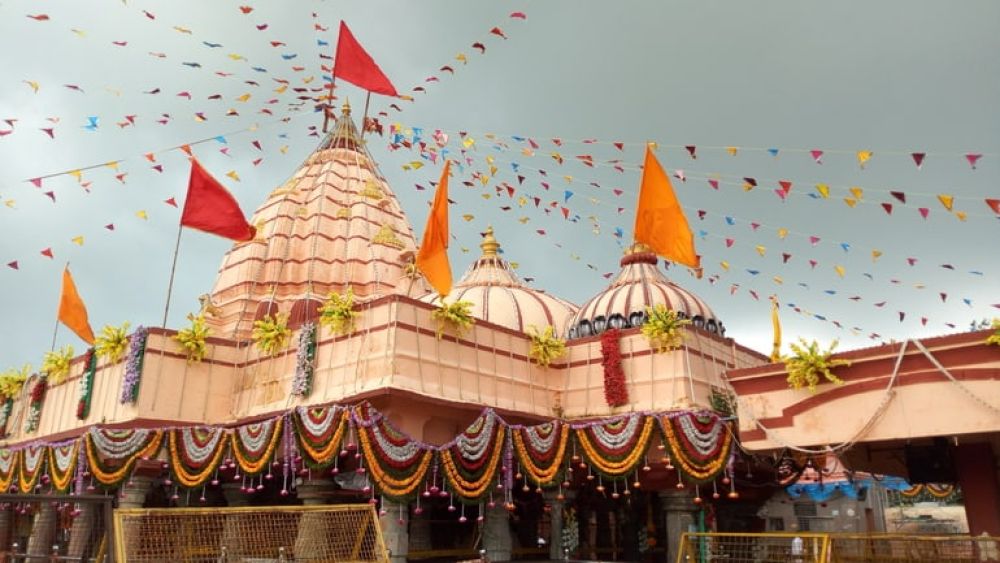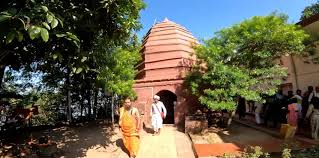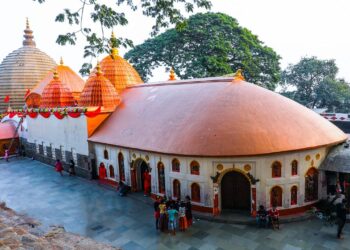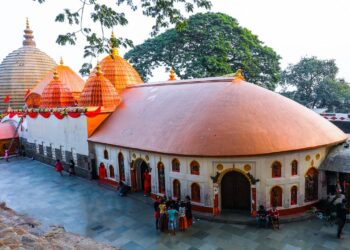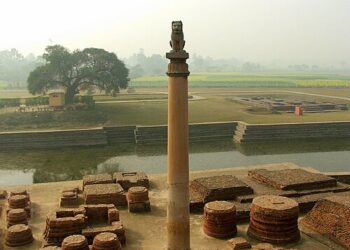By the calm Shipra River in Ujjain, Madhya Pradesh, stands the Chintaman Ganesh Temple, a sacred spot where devotees pray to Lord Ganesh, the one who removes obstacles. Built long ago, in the 12th century, the temple is located now in the middle of the town’s market. The Ganesha idol enshrined in this temple is supposed to be swayamabhu (self manifested). Locally, Ganesha is also referred to as Chintaman. His consorts, Ridhhi and Siddhi, flank Chintaman, the assuager of all worries.
Notable Fact: The Ganesh idol here is said to have formed on its own, not shaped by hands.
Mythological Significance
Chintaman Ganesh Temple holds old tales. One story says Sita, wife of Lord Rama, set a Ganesh idol here in their wandering days to guard the land. Another tells of a sage who prayed to Ganesh to ease his heavy heart, and calm came after his trust. Folks say prayers here chase worries and bring wise thoughts. The temple’s link to Ganesh ties it to fresh starts and good luck, standing close to Shiva’s great shrine at Mahakaleshwar. The name “Chintaman” means “soother of cares,” showing Ganesh’s kind ways. In the traditional times, the Lord is known as Chintaharan which literally means remover of all worries and tensions. The temple is thronged by crowds of people that come to do away with all their worries at the shrine of the Lord. The term Chintamani is another name used for Lord Vishnu, who is considered as the preserver of the Universe as per Hindu Mythology. Also called Vighneshwara, the moderator of grief, Ganesha is always the first to be worshipped in the Hindu pantheon, lest he decide to sow obstacles in the devotees’ path.
Historical Background
The temple’s roots go way back to the 12th century, built by Paramara kings. Ujjain was a holy town, rich with faith. A stone from 1150 marks its early start. Islamic raiders broke nearby shrines in the 13th century, but Maratha lords fixed Ujjain’s temples in the 1700s. It is also believed that the original temple dates back to the Ramayan age and the temple is stablished by Sita.
This temple was built in Vikram Samvat, i.e. in 155 by Maharaja Vikramaditya according to Sriyantra. After that, it was renovated during the Peshwa period. Whereas the present temple was renovated during the reign of Ahilyabai Holkar, the idol of Shri Ganesh ji installed in the temple was standing. Today, the idol is half sunken inside the ground, due to which half of the idol can be seen.
Architecture of Chintaman Ganesh Temple
Chintaman Ganesh Temple sits on a small bit of land by the Shipra, made in plain style. The main part has a low stone top, carved with lotus blooms, elephants, and Ganesh’s rat, all in gray stone. Inside, it’s has a small black idol, holding a sweet and axe, lit by ghee lamps. The inner walls got plain stone with old prayers words. The finely-carved stone pillars in the assembly hall and the white shrine define the age-old sanctity of the temple.
A tiny hall has four pillars, carved with gods and leaves. Lion is also sitting on the top of this temple along with the domes. Small shrines for Durga, Hanuman, and halls, and Lakshmi are in the yard, made of stone. The Durga shrine shows her with a lion, for might. The Hanuman one, from 1400, has him kneeling, for strength. The Lakshmi one shows her with coins, for riches. The stone yard feels holy, by the river. A plain gate has Ganesh’s shape. A water ghat, Shipra’s edge, is for ritual baths. Pillars tell Ganesh’s stories, guiding those who pray. The river’s soft murmur brings peace.
Rituals and Festivals
The temple stirs for festivals. Ganesh Chaturthi, in August or September, is big, with days of songs and sweet gifts. Maghi Ganesh Jayanti, in February, marks Ganesh’s birth. Diwali, in October or November, lights up for joy. Kartik Purnima, in November, draws devotees for Shipra dips. Sankashti Chaturthi, each month, sees fasts for Ganesh.
Each day starts with Mangla Aarti at 6:00 AM, offering milk. Abhishekam at 8:00 AM uses water. Evening aarti at 7:00 PM has lamps. Special prayers, like Ganesh Homam, cost ₹100–400 and give blessings blessings. A stall hands out free laddoos for prasad. Wednesdays, folks bring yellow flowers for smarts and peace.
Information for Travelers
Hours and Entry: Open every day, 6:00 AM to 8:00 PM. It’s free to enter, but prayers cost ₹100–400. No pictures in the inner room.
Clothing: Wear clothes covering shoulders and knees. Women for prayers wear sarees or suits, men wear kurtas.
How to Get There:
Air: Indore Airport, 55 km off, is closest. Taxis take 1 hour, cost ₹1200–2000.
Train: Ujjain Station, 5 km away, links to Bhopal (3 hours). Autos cost ₹50–100.
Road: Buses from Indore (1 hour) reach Ujjain. Taxis cost ₹800–1200. Roads are quiet.
Best Time to Visit:
October to March is cool, 20–30°C. Weekdays are calm. Ganesh Chaturthi’s busy, so plan early.
Nearby Attractions:
Mahakaleshwar Jyotirlinga, 5 km away, is a Shiva shrine.
Kal Bhairav Temple, 3 km away, offers liquor prasad.
Harsiddhi Temple, 4 km away, is a Shakti Peetha.
Ram Ghat, 3 km away, is a Shipra bath spot.
Sandipani Ashram, 2 km away, was Krishna’s school.
Final Thoughts
Chintaman Ganesh Temple in Ujjain, Madhya Pradesh, a sacred place in India’s heart, is a divine shrine where one’s obstacles all wash away. Lord Ganesh’s gentle touch reaches all who come, making it a spot you must see among India’s holy places.
